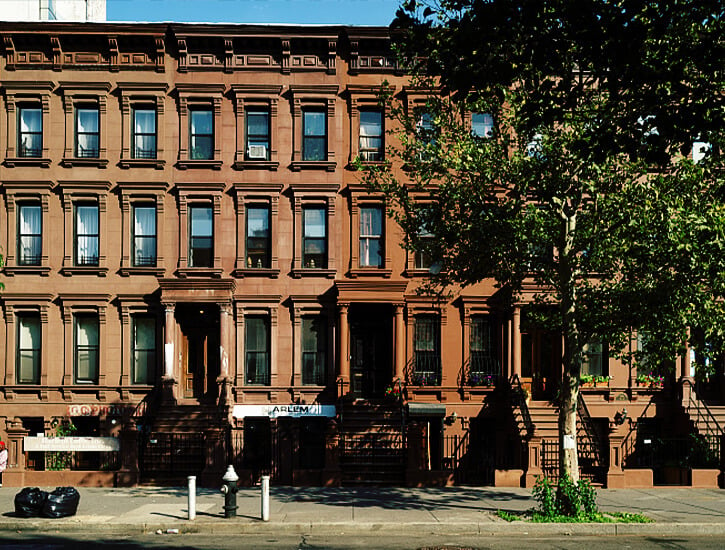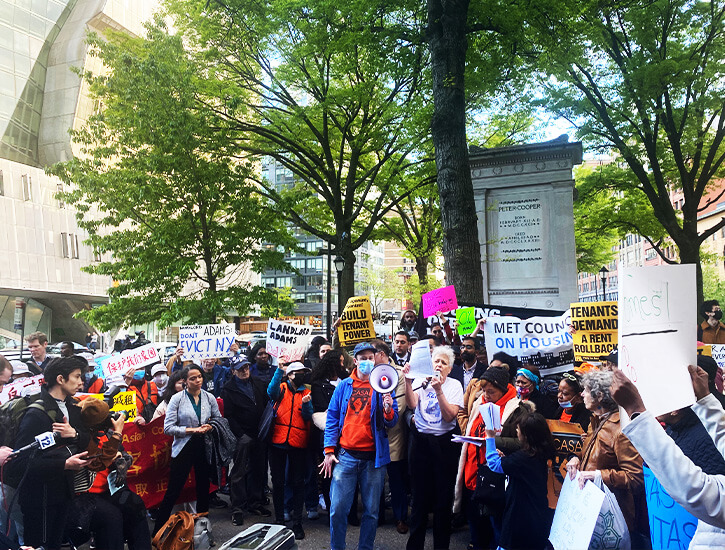Too Damn High
The notorious RGB moves to increase rents on stabilized apartments Library of Congress.
Library of Congress. o
r
d
F
a
c
t
o
r
y
Outside the entrance to Cooper Union’s Great Hall, a sign asked for no drums or noisemakers so that the New York City Rent Guidelines Board could “deliberate,” “hear each other,” and make their decision in peace. Instead, the opposite happened. For the next hour or so, protest chants mostly drowned out the meeting’s speakers, and advocates rushed the stage when the RGB’s members were about to take a preliminary vote on this year’s rent increases for rent-stabilized apartments in New York City. In the absence of the drums that had peppered the press conference that took place outside the hall prior to the meeting, a cowbell clanged, and people smacked the room’s white pillars to create a thunderous sound. “It’s time for us to take back the city,” rent-stabilized tenant Natalia Marques told me after she jumped on stage. “My hatred of landlords and exploitation really drives me.”
Marques, like me, is one of 2.4 million New Yorkers who live in a rent-stabilized apartment, which comprise roughly 44 percent of the city’s rental units. Being on a rent-stabilized lease means that the amount you pay your landlord each year can only increase by a standardized percentage (or freeze, or, if you’re really lucky, decrease). Rent-stabilized tenants also have the right to renew their leases. But people who live in these apartments are now facing a second year of significantly higher rent increases than in years past, thanks to New York City mayor Eric Adams’s landlord-friendly Rent Guidelines Board. The RGB is a nine-person panel that sets the rent adjustments for stabilized units based on public meetings, hearings, and research. Members are appointed by the mayor. They include two landlord representatives, two tenant representatives, and five “public” representatives, one of whom, Arpit Gupta, has gone on record saying he is a “l(fā)ittle skeptical of rent control.”
“My hatred of landlords and exploitation really drives me.”
The board’s latest vote was cast amid concerns about an impending recession; an eviction crisis that has tenant lawyers across the city backlogged, according to Metropolitan Council on Housing organizer Anna Baker-Heans; and the ongoing effects of the pandemic, which saw hundreds of thousands of New Yorkers lose their jobs. During former mayor Bill de Blasio’s eight-year tenure, the highest annual increases approved by the board were 1.5 percent on one-year leases and 2.75 percent on two-year leases; they also instituted multiple rent freezes. In contrast, under Adams’s administration, rent on one-year leases went up by 3.25 percent after last year’s vote, and on two-year leases by 5 percent.
At the meeting, many of the board members looked visibly angry: none more so than landlord representative Christina Smyth, who in March tweeted out an image of text containing the phrase “if regulation goes too far, it will be recognized as a taking.” She was quoting Supreme Court Justice Oliver Wendell Holmes’s decision in the 1922 case Pennsylvania Coal Co. v. Mahon, which established the principle of a “regulatory taking,” said to occur when government regulations of private property deprive the owner of its value. In other words, Smyth’s post seemed to imply that tenant protections which go “too far” are unconstitutional.
Up until the protesters prevented him from continuing, RGB chairman Nestor Davidson, a contributor to the conservative Federalist Society, stoically droned on—to himself and himself alone at a certain point, as no one could hear him over the rolling chants. The closest he got to becoming audible, after another feeble mic volume increase, was when Davidson tried to introduce the motion for Order 55—presumably the guidelines for rent-stabilized leases beginning between October 1, 2023 and September 30, 2024—announcing, “before we do so, I want to remind the public that these are preliminary guidelines.” It was about forty seconds later that a group of progressive council members and tenants jumped on stage.
Among those council members was Alexa Avilés, who represents District 38 in southwest Brooklyn. Avilés said that the stakes of the rent increase were too high to be dainty in opposing them. “We were planning to enter the stage a number of different ways, depending on security and the aggression of people and what people could do, what physical abilities,” she told me. The increases last year were dire enough, she said, and the RGB is stacked in a way that serves the real estate industry, not people living in rent-stabilized units. “We’d have a very different outcome if you saw more people impacted by these hikes” on the board, Avilés said.
The RGB ended up voting for a 2 to 5 percent increase for one-year leases, and a 4 to 7 percent increase for two-year leases. This wasn’t the worst-case scenario: the two landlord representatives had put forth a bid for rent increases of 7 to 10 percent for one-year leases and 11 to 14 percent for two-year leases, which was voted down. Genesis Aquino, who represents tenants and lives in a rent-stabilized unit herself, offered a motion to barely raise or even roll back rent, proposing a 1 percent decrease to 1 percent increase for one-year leases and 0 to 2 percent increase for two-year leases. But this, too, was voted down.

The final guidelines will be determined in June, though reporting has shown that the preliminary vote often sets the stage for the end results. Nevertheless, people are gearing up for a fight. “We need to get some of these people to actually listen to the true impacts and stop basing decisions on your real estate buddy friends or even projections. We all know projections are modeled for particular audiences,” said Avilés. Flatbush tenant Natalia Marques, who was at the meeting with the Party for Socialism and Liberation, is worried about the impact the new increases will have on her neighbors: “There’s some low-income people, people on disability, those who get assistance from organizations to pay their rent already, people that are going through eviction cases.” She questioned landlords who say they need the increases to cover the cost of maintaining their properties, considering the shoddy state of many rent-regulated apartments. Her building has cockroaches, elevators that break down, and ceilings that have caved in, she said. But these conditions have encouraged people to get to know their neighbors: “To some extent, the last thing landlords want us to do is talk to each other.” When Marques was on the stage, she saw one of the landlord reps laughing as tenant representative Aquino spoke. “You can tell that’s how they see us, that’s how they see tenants,” she said. “They look down on us. . . . I don’t even know if they see us as people, quite frankly.”
Cesar Reyes is another a rent-stabilized tenant who attended the meeting. “I’m a Harlemite,” he told me afterwards. “I’ve been here my whole life. But this is something that could potentially displace me and my family.” He was already feeling last year’s increase, saying it had caused him to fall behind on utility bills. Reyes currently pays $1,800 a month for his one-bedroom unit; if an increase of 7 percent on two-year leases goes through, he’d be shelling out an extra $126 a month, or $1,512 a year. People act concerned about homelessness, Reyes said, but rent increases on regulated apartments contribute to that problem: “It’s definitely indirect violence to these communities. Evictions equal death.”
Baker-Heans, the Metropolitan Council on Housing organizer, said she works with a lot of tenants who still owe back rent from when the pandemic first hit. “They can’t afford the current rent, let alone the increase. Evictions are happening again at crazy speeds.” In October of last year, The Cityreported that less than 10 percent of tenants who were up for eviction had been assigned a lawyer in the month prior, despite a right to counsel for low-income tenants in New York. At the same time, the stable of rent-regulated apartments across the city seems to be shrinking: another investigation by The City revealed that one hundred sixteen thousand rent-regulated apartments were lost between 2019 and November 2022.
A lot of tenants still owe back rent from when the pandemic first hit.
Then there is the practice of “warehousing,” where landlords deliberately leave apartments empty to fabricate housing scarcity and artificially drive up rents. More than sixty thousand rent-stabilized apartments were left vacant in 2022; the parlor floor one-bedroom apartment in the building I reside in has been empty for the entirety of the two years I’ve lived there, after a family of four moved out following a decade of tenancy. The recent historic rent spikes on unregulated apartments make this situation all the more dire, especially as progress continues to stall on New York state’s Good Cause Eviction bill, which would enshrine the rights of all tenants to renew their leases, protect them against rent increases above either 3 percent of the previous rent or one and one-half times the annual percentage change in the Consumer Price Index, and ensure landlords must have an adequate reason to kick tenants out.
There are many groups dedicated to challenging the dismal state of New York housing, such as Just Fix, which helps tenants find out if they are living in a rent-stabilized apartment and allows them to see what previous tenants paid. However, when it comes to the enforcement of much housing law, there is a lack of teeth: for example, other than filing an overcharge complaint with the Office of Rent Administration, the primary way to get a landlord to stop illegally charging market rent on a rent-stabilized unit is to take them to court for back pay, something many tenants are reluctant or lack the time and means to do.
Ahead of the final RGB vote on rent increases, there will be hearings held in the Bronx, Queens, Brooklyn, and virtually during the first two weeks of June, as well as public meetings on May 25 and on June 21, when the board will reach its final decision. When asked if a potential rent strike could be on the table, Councilwoman Avilés said she would defer to tenants on what to do next. “People will be in the streets,” tenant organizer Baker-Heans said, “we’ll be mobilizing. . . . New Yorkers are not going to be able to afford to live in New York anymore if we don’t have a rent rollback.” Marques agreed: “I’m going to be at every single hearing.” It’s the only real outlet for the voice of tenants, she told me. “We didn’t vote these people in,” Marques said of the board. “We didn’t vote for the rent increases. We have no say.”